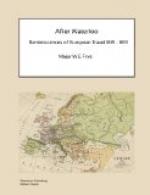I shall return in a day or two to Rome, having seen nearly all that Naples affords. I have now full liberty to die when I chuse according to the proverb: Veder Napoli e poi morire.
Naples certainly is, taking it all in all, the most interesting city in Europe, for it unites every thing that is conducive to the agremens of life. A beautiful city, a noble bay, a vast commerce, provisions of the best sort, abundant and cheap, a pleasant society, a delicious climate, music, Operas, Balli, Libraries, Museums of Painting and Sculpture; in its neighbourhood two subterraneous cities, a volcano in full play, and every spot of ground conveying the most interesting souvenirs and immortalized in prose and verse. Add thereto the vapour baths of sulphur for stringing anew the nerves of those debilitated by a too ardent pursuit of pleasure, and the Fountain of St Lucia for those suffering from a redundancy of bile. Now tell me of any other residence which can equal this? Adieu.
ROME, 22nd Octr.
Nothing material occurred on my return from Naples to Rome; but on the 2d day after my arrival I made an excursion to Tivoli, which is about eighteen miles distant from Rome. I passed the night at the only inn at Tivoli. The next morning I walked to the Villa d’Este in this neighbourhood, which is a vast edifice with extensive grounds. Here on a terrace in front of the villa are models in marble of all the principal edifices and monuments, ancient and modern, of Rome, very ingeniously executed. From the Villa d’Este is a noble view of the whole plain of Latium and of the “Eternal City.”
From hence I walked about two miles further to visit the greatest antiquity and curiosity of the place, which is the Villa or rather the ruins of the celebrated Villa built by Adrian, which must have been of immense size from the vast space of ground it occupies. It was intended to unite everything that the magnificent ideas of a Prince could devise who wished to combine every sort of recreation, sensual as well as intellectual, within the precincts of his Palace; columns, friezes, capitals, entablatures and various other spoils of rich architecture cover the ground in profusion: many of the walls and archways are entire and almost an entire cupola remains standing. Besides the buildings above ground, here are cellars under ground intended as quarters for the guards and capable of holding three thousand men, as well as stabling for horses. In the inclosure of and forming part of this Villa, which covers a circumference of seven miles, were a gymnasium, baths, temples, a school of philosophers, tanks, a theatre, &c. The greatest part of these buildings are choaked up and covered with earth, since it is by excavation alone that what does appear was brought to light. It was by excavation that a man discovered a large hall wherein he found the nine beautiful statues of the Muses, which now adorn the Museum of the Vatican; and no doubt if the Roman government would recommence the excavations many more valuables might be found. Hadrian’s villa has already furnished many a statue, column and pilaster to the Museums, churches and Palaces of Rome.




